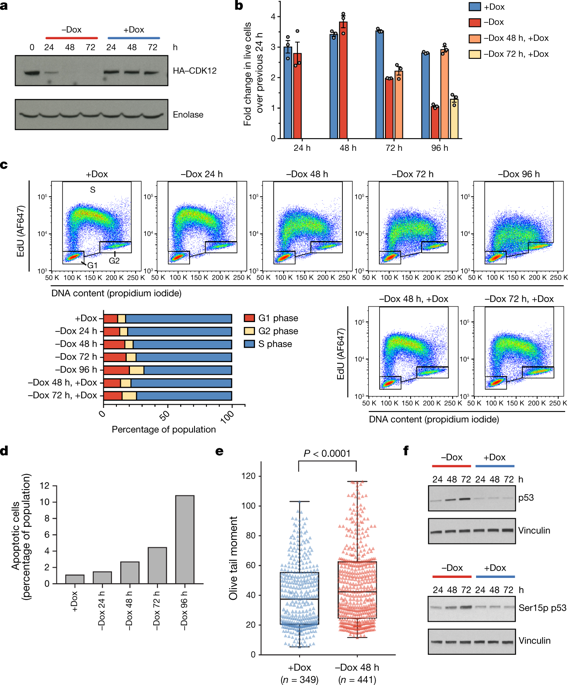Our official English website, www.x-mol.net, welcomes your
feedback! (Note: you will need to create a separate account there.)
CDK12 regulates DNA repair genes by suppressing intronic polyadenylation
Nature ( IF 50.5 ) Pub Date : 2018-11-28 , DOI: 10.1038/s41586-018-0758-y Sara J Dubbury 1, 2 , Paul L Boutz 1, 3 , Phillip A Sharp 1, 2
Nature ( IF 50.5 ) Pub Date : 2018-11-28 , DOI: 10.1038/s41586-018-0758-y Sara J Dubbury 1, 2 , Paul L Boutz 1, 3 , Phillip A Sharp 1, 2
Affiliation

|
Mutations that attenuate homologous recombination (HR)-mediated repair promote tumorigenesis and sensitize cells to chemotherapeutics that cause replication fork collapse, a phenotype known as ‘BRCAness’1. BRCAness tumours arise from loss-of-function mutations in 22 genes1. Of these genes, all but one (CDK12) function directly in the HR repair pathway1. CDK12 phosphorylates serine 2 of the RNA polymerase II C-terminal domain heptapeptide repeat2–7, a modification that regulates transcription elongation, splicing, and cleavage and polyadenylation8,9. Genome-wide expression studies suggest that depletion of CDK12 abrogates the expression of several HR genes relatively specifically, thereby blunting HR repair3–7,10,11. This observation suggests that the mutational status of CDK12 may predict sensitivity to targeted treatments against BRCAness, such as PARP1 inhibitors, and that CDK12 inhibitors may induce sensitization of HR-competent tumours to these treatments6,7,10,11. Despite growing clinical interest, the mechanism by which CDK12 regulates HR genes remains unknown. Here we show that CDK12 globally suppresses intronic polyadenylation events in mouse embryonic stem cells, enabling the production of full-length gene products. Many HR genes harbour more intronic polyadenylation sites than other expressed genes, and these sites are particularly sensitive to loss of CDK12. The cumulative effect of these sites accounts for the enhanced sensitivity of HR gene expression to CDK12 loss, and we find that this mechanism is conserved in human tumours that contain loss-of-function CDK12 mutations. This work clarifies the function of CDK12 and underscores its potential both as a chemotherapeutic target and as a tumour biomarker.The kinase CDK12 suppresses usage of intronic polyadenylation sites and thereby promotes the expression of genes involved in homologous recombination DNA repair.
中文翻译:

CDK12 通过抑制内含子多聚腺苷酸化来调节 DNA 修复基因
减弱同源重组 (HR) 介导的修复的突变会促进肿瘤发生并使细胞对导致复制叉塌陷的化学治疗剂敏感,这种表型称为“BRCAness”1。BRCAness 肿瘤由 22 个基因的功能丧失突变引起。在这些基因中,除了一个 (CDK12) 外,所有基因都直接在 HR 修复途径中起作用 1。CDK12 磷酸化 RNA 聚合酶 II C 端结构域七肽重复序列 2-7 的丝氨酸 2,这是一种调节转录延伸、剪接、切割和聚腺苷酸化的修饰 8,9。全基因组表达研究表明,CDK12 的消耗会相对特异性地消除几种 HR 基因的表达,从而减弱 HR 修复3-7,10,11。这一观察结果表明 CDK12 的突变状态可以预测对针对 BRCAness 的靶向治疗的敏感性,例如 PARP1 抑制剂,并且 CDK12 抑制剂可能会诱导具有 HR 能力的肿瘤对这些治疗敏感 6,7,10,11。尽管临床兴趣不断增加,但 CDK12 调节 HR 基因的机制仍然未知。在这里,我们表明 CDK12 全局抑制小鼠胚胎干细胞中的内含子多聚腺苷酸化事件,从而能够产生全长基因产物。许多 HR 基因比其他表达基因具有更多的内含子多聚腺苷酸化位点,这些位点对 CDK12 的丢失特别敏感。这些位点的累积效应解释了 HR 基因表达对 CDK12 缺失的敏感性增强,我们发现这种机制在包含功能缺失 CDK12 突变的人类肿瘤中是保守的。
更新日期:2018-11-28
中文翻译:

CDK12 通过抑制内含子多聚腺苷酸化来调节 DNA 修复基因
减弱同源重组 (HR) 介导的修复的突变会促进肿瘤发生并使细胞对导致复制叉塌陷的化学治疗剂敏感,这种表型称为“BRCAness”1。BRCAness 肿瘤由 22 个基因的功能丧失突变引起。在这些基因中,除了一个 (CDK12) 外,所有基因都直接在 HR 修复途径中起作用 1。CDK12 磷酸化 RNA 聚合酶 II C 端结构域七肽重复序列 2-7 的丝氨酸 2,这是一种调节转录延伸、剪接、切割和聚腺苷酸化的修饰 8,9。全基因组表达研究表明,CDK12 的消耗会相对特异性地消除几种 HR 基因的表达,从而减弱 HR 修复3-7,10,11。这一观察结果表明 CDK12 的突变状态可以预测对针对 BRCAness 的靶向治疗的敏感性,例如 PARP1 抑制剂,并且 CDK12 抑制剂可能会诱导具有 HR 能力的肿瘤对这些治疗敏感 6,7,10,11。尽管临床兴趣不断增加,但 CDK12 调节 HR 基因的机制仍然未知。在这里,我们表明 CDK12 全局抑制小鼠胚胎干细胞中的内含子多聚腺苷酸化事件,从而能够产生全长基因产物。许多 HR 基因比其他表达基因具有更多的内含子多聚腺苷酸化位点,这些位点对 CDK12 的丢失特别敏感。这些位点的累积效应解释了 HR 基因表达对 CDK12 缺失的敏感性增强,我们发现这种机制在包含功能缺失 CDK12 突变的人类肿瘤中是保守的。











































 京公网安备 11010802027423号
京公网安备 11010802027423号